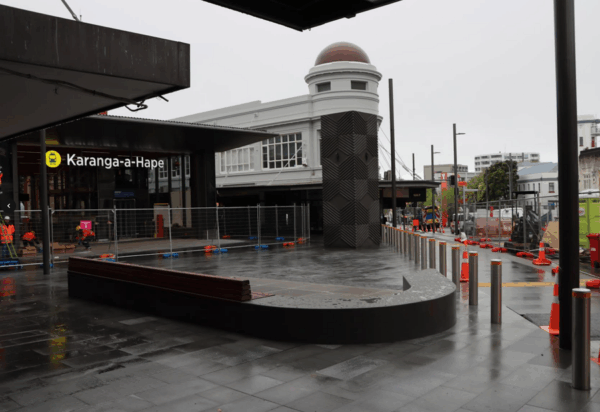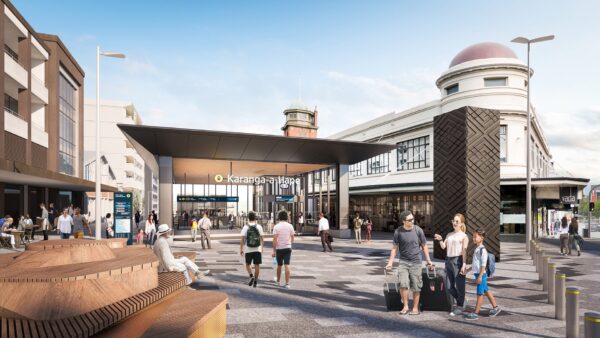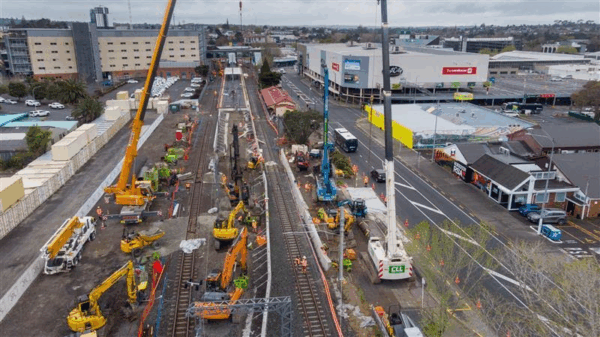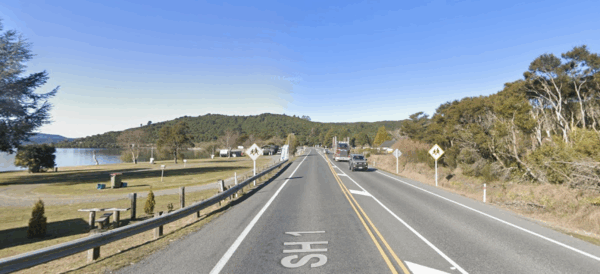It’s local government election eve – last chance to get your votes in before noon on Saturday 11 October! Voting is valuable. As Hayden Donnell puts it in his famously witty way, city is made of council. And outcomes can depend on a single vote.
- If you have your voting papers, you can pop your completed ballot into one of the orange drop boxes at supermarkets, libraries, or transport hubs.
- If you haven’t yet received a ballot, or are not enrolled, you can still vote by enrolling (or updating your details) online, and then going to one of the special voting locations or events.
Go vote! And while we wait to hear the outcome that will determine the direction of our city over the next three years, here are some of the stories that caught our attention over the last week…
This Week in Greater Auckland
- On Wednesday, Connor highlighted what this election means for transport in Auckland.
- On Thursday, we ran a guest post from Malcolm McCracken looking at progress on the Carrington housing development.
Beresford Square re-opens!
As the City Rail Link moves closer to completion, we’ll be getting back more of our public spaces and streets. This was highlighted by the reopening of Beresford Square last week:
After almost six years of construction, the City Rail Link (CRL) project is today returning a much-loved, new and improved community space to the Karangahape Road community when Beresford Square reopens.
“We know Beresford Square is an important focal point for the community and we’re delighted to return to them a vibrant plaza that is upgraded and people-focused,” says City Rail Link Ltd’s Chief Executive, Patrick Brockie. “Community support is a critical part of delivering a project successfully and I want to thank our fantastic neighbours for their patience and goodwill during many years of construction.”
It’ll be even better once the fencing around the station entrance comes down, and the Pitt St upgrade is completed.
 Beresford Square, slightly gloomy photo via CRL media release
Beresford Square, slightly gloomy photo via CRL media release
 Beresford Square entrance area on a nicer day, render via CRL
Beresford Square entrance area on a nicer day, render via CRL
Rail network school holiday works completed
As part of working towards CRL opening, KiwiRail has been doing a lot of work around the network. The recent school holidays saw parts of the network closed for upgrades to bring it up to speed.
“A huge amount has been achieved in the school holiday upgrade, with our renewal of rail infrastructure around three major South Auckland train stations now largely complete,” said KiwiRail Chief Metro and Capital Programme Officer David Gordon.
“In West Auckland, the second platform extension and the new third platform is taking shape in Henderson. We are in the final stages of the massive, $1.9 billion upgrade of Auckland’s metro rail network in preparation for the opening of City Rail Link.
“While further closures will be needed in 2026 to complete works, we’re making great strides in ensuring the Auckland network is safe and reliable to support the greater frequency of trains CRL will enable each hour.”
More than 200 team members worked day and night to complete the work that’s been underway for around six months around Te Mahia, Takanini and Homai stations, along with other renewals across the network. These upgrades will help trains run more smoothly and reliably and boost overall network resilience.
More than 150 workers were in Henderson over the school holiday to install 55 piling structures of up to 18m deep, and beams that will support the 75-metre-long third platform currently under construction.
There is still a lot of work to be done, with a big focus on West Auckland during the next two full network closures: the four-day (24-27 October) extended Labour weekend, and the four-week Summer Rail Upgrade, which kicks off on 27 December.
From the end of October, RNR teams will be carrying out drainage and investigation works from Fruitvale Road Station to Swanson on the Western Line and in the vicinity of Morningside in central Auckland.
To support these works, KiwiRail will use ‘single line running’ on the Western Line to allow our teams to safely work on one set of rails while trains continue to run on the second set. Single line running results in changes to train frequency and changes to platforms for customers.
One detail that immediately sticks out: the comment that “further closures will be needed in 2026”. Does this just refer to the upcoming Christmas/New Year period, or further into 2026, even after CRL opens?
It would be awkward to see major closures coinciding with holidays right at the point where Aucklanders are keen to get out and enjoy the promised benefits of CRL…

Construction work at Henderson Station. Image: KiwiRail
City centre love fest
Comedian Chris Parker is something of an ardent urbanist. His “local tourism” reels of our fair city were a highlight in the era of pandemic travel restrictions. In this Spinoff interview about life after dark, he shines some optimism on our city centre (and shares some great tips for where to eat, of an evening).
OK, let’s say you’ve just finished a show, where are you going to eat?
If I’ve watched a show, I’m running to Sue’s Dim Sum on Lorne Street. When you perform, the trick is to find the hot pocket of the audience, and you breathe oxygen into them, and it ignites the audience around them – Lorne Street is that, it has energised the city around it. Sue’s Dim Sum is really good. The spring onion noodle is great there.
What do you say to people who ask what’s happening in Auckland at night?
That’s a really good question. I’d say a lot happens in Auckland, but I think more can happen. I think the CRL is going to be really game-changing. It’s just that Auckland’s kind of got her braces on, and she’s on Roaccutane – but we’re going to have a hair-down, glasses-off reveal soon, and we’ll be like ‘oh my god’. I love seeing that beauty through the construction. I can see the potential of it all. And that’s my Christchurch mentality coming through, because that city was under construction for 10 years.
Auckland Airport transport moves
An item at BusinessDesk notes that AT’s former Director of Infrastructure and Place is moving to Auckland Airport as their new chief infrastructure officer. This brings to mind lots of opportunities for better transport to (and through) the airport precinct. Not least, the long-noted gaps in safe cycling facilities within the airport precinct – surely an easy low-hanging fruit for reporting against sustainability KPIs?
Safety first and last
We noted on Bluesky recently that on 29 September, there were three crashes in one day around the motu, in areas where higher speed limits had been mandated by the current government:
- A pedestrian seriously injured on Botany Road in Auckland (where the speed limit was raised from 50km/h to 60km/h)
- Serious injuries to a person and animals after a stock truck rolled on the Napier-Taupō highway
- And six people injured in a serious crash on SH1 just south of Taupō
A correction: it transpires that the SH1 crash south of Taupō (at the Tauranga-Taupō bridge) was in a location that had somehow escaped the speed-raise-blitz back to 100km/h. It’s not clear how this section was retained at 60km/h, as it seems to fall under the definitions in Simeon Brown’s revised Speed Rule. Local lobbying, or administrative oversight, or…?
The point remains that – as predicted – on streets and highways where speeds have recently been raised, people are being harmed in potentially preventable serious crashes. And in each case above, the road was closed for several hours, raising questions around the alleged “productivity” of the higher speed limits.
One piece of good news, however! Another stretch of SH1 along the shores of Lake Taupō (the one that famously cuts through a holiday camp ground in Motutere) is now up for a return to slightly safer speeds.
Google Streetview of Motutere Top 10 Holiday Park on SH1: would you cross here?
Waka Kotahi/ NZTA notes this is due to community pushback on safety, and concerns about how the previous consultation was communicated:
Since the speed limit was reinstated to 100km/h in May 2025, NZTA has received considerable feedback from the local community, iwi, council representatives, as well as the freight industry. People feel very strongly that a speed limit of 100km/h is inappropriate in the Motutere holiday park area and that a return to 60km/h is needed for safety reasons. We also received feedback that people didn’t understand the map used in earlier consultation and mistakenly thought the holiday park area wasn’t included and would remain at 60km/h.
Feedback is open until 5pm on Monday 17 November, and the survey form is here.
Well, well, Welly
Via Newsroom, interesting stats from the first four months of the cones hotline, a $100,000 initiative.
Now this is going to come as a shock but it seems that the Cones Hotline is a complete waste of time and money.
— Clint Fern (@clintfern.bsky.social) 2025-10-08T19:48:48.654Z
And in what may be a first, in a story about a beloved small Wellington beach affected by a recent seawall build (which happens to include a cycleway), unhappy residents aren’t necessarily blaming the cycleway:
[Friends of Hataitai Beach member Susette] Goldsmith said locals had “basically lost the beach”.
…
Goldsmith wanted Wellington City Council to put some more sand on the beach.
“We need another 400 cubic metres of sand … put back in here for it.”
She said people were “really angry” about the reported changes.
“This was a little beach with a lot of character; it has lost it completely.”
Goldsmith noted that she was very happy that there was now a cycleway in the area because of the seawall changes.
Autonomous vehicles and cities
David Zipper writes in Vox about how how autonomous vehicles could make cities much worse, noting “a self-driving car traffic jam” is on the way:
AVs offer some undeniable benefits: Unlike humans, they cannot drive drunk, distracted, or tired. They make car trips easier, less stressful, more frictionless — in a word, nicer. The growing availability of AVs is likely to make many people respond just as they would to any other improvement in a product or experience: They will use it more often.
But that could prove disastrous for cities, causing crushing congestion (not to mention widening the gulf between those happily ensconced in their AVs and those stuck in buses crawling through gridlock). This is not pure speculation: Over the last 15 years, the rise of ride-hail, a service similar to robotaxis, has increased total driving, thickened congestion, and undermined transit. Autonomous vehicles, which offer privacy and service consistency that ride-hail cannot, could turbocharge the number of cars on the road, making a mess of urban streets. (Waymo did not comment on the record for this story, and Zoox and Tesla did not respond to requests for comment.)
AVs are coming, but they cannot just plug and play into our existing transportation networks. If cities don’t update their rulebooks, they risk repeating the mistakes of the last century.
He also makes some suggestions for helping to address them, under these headings:
- Put a price on congestion
- Get a handle on the curb
- Stop building new parking (and charge market prices for existing spots)
- Automate enforcement
- Solving for the present as well as the future
 Image via linked article
Image via linked article
Want a better city? Choose it
Live from New York
A couple of interesting videos on transport history in the Big Apple. First up, a summary of the battle for New York’s subway system…
And a look at the deep history of Wall St
Good energy news: that’s a lot of electrification!
Not nearly enough is made of the incredibly impressive feat Indian Railways has made to electrify almost 100% of its 135,000km of track, while also growing renewable sourcing. Huge:timesofindia.indiatimes.com/business/ind…
— Patrick Reynolds for a greater Auckland (@patrickreynolds.bsky.social) 2025-10-05T07:25:45.680Z
In related news, the worldwide growth in renewables has reached a new milestone.
Renewable energy overtook coal as the world’s leading source of electricity in the first half of this year – a historic first, according to new data from the global energy think tank Ember.
Electricity demand is growing around the world but the growth in solar and wind was so strong it met 100% of the extra electricity demand, even helping drive a slight decline in coal and gas use.
…..
Solar power delivered the lion’s share of growth, meeting 83% of the increase in electricity demand. It has now been the largest source of new electricity globally for three years in a row.
Most solar generation (58%) is now in lower-income countries, many of which have seen explosive growth in recent years.
That’s thanks to spectacular reductions in cost. Solar has seen prices fall a staggering 99.9% since 1975 and is now so cheap that large markets for solar can emerge in a country in the space of a single year, especially where grid electricity is expensive and unreliable, says Ember.
And meanwhile, dirtier energy is (or should be) on its way out:
This shouldn't need to be said, but coal is failing in the year 2025 because it is more expensive than alternative solutions. You can't polish this lump.
— Dustin Moskovitz (@moskov.goodventures.org) 2025-09-29T15:29:07.012Z
Have a great weekend. We’ll certainly be keeping an eye on the election results tomorrow!


 Processing...
Processing...
In a post-truth world, if the capitalist facts (like coal energy costs) don’t fit your mindset, you just do what govts have always done: subsidise, subsidise, subsidise (while blaming others for being piggies at the trough). They have just gotten more brazen about it.
If you declare renewables “woke” and make people hate everything and everybody “woke”, they don’t mind paying the premium on non-woke energy.
What is renewable energy?
Seems to me that it has different definitions in different jurisdictions. Nuclear, natural gas is renewable in the EU for example. So not so sure about the wokeness, it seems more to be about the economy and what is a strategic for nation states.
And while its nice that Mr Reynolds sees a positive note in India (Railways), India is expanding its coal power capacity by 46% from 210 GW currently to 307 GW by 2035. So renewable energy for Indian railways is being replaced by coal for households. Lovely…
India accounts for 7% of the worlds Co2 emissions and their emissions are increasing. They are dwarfed by China’s 33% of world emissions and increasing (and for those of you that cry wolf over Trump, the US is 13% and decreasing). Might think of that next time we buy equipment (hello Auckland buses)/toys or whatever from China…
I thought China has reached peak emissions and they’re expected to drop in the future. Officially it was meant to be 2030, but they’re ahead of schedule due to renewables and EVs.
China’s emissions *per person* are a little over half that of the USA.
India’s population is about 18% of all humanity, so emitting 7% of world CO^2 would give plenty of room for equitable growth.
Both countries manage this while handling much of the world’s dirty work when it comes to industries like steel.
Yes it’s a bit much to blame China for its emissions when every other country has outsourced its dirty industries there (except for dairy and beef of course).
$25,000 to change a short section of road to 60kmh??? Seriously??? No wonder the public get so up in arms at speed reductions should just be stickers over a sign for maybe a couple hundred $. Someone is making money hand over fist and it isn’t the taxpayer.
Airport transport improvement idea: extend the 30 bus route to run express from Onehunga to the airport. That way you get a one-seat city-to-airport PT ride with very little additional investment. Plus there are bus lanes on the motorway for a good chunk of that route.
It might be the weather in the picture compared to the artist’s impression, but the bench on Beresford Square looked much better in the draft 🙁
In other news this week Viv Beck and Tom Dillane both had articles in the Herald moaning about how terrible the central city is.
Silly me – I thought Viv was supposed to be the cheerleader for local business, but it seems she commissioned a survey of the property owners who all think the place is actually worse now than it was when Queen Street was a four-lane heaving stinking mass of boy racers.
Dillane, of course, is the new Orsman of the Apocalypse who amplified the negative complainers about the streetscape improvements a few years ago.
I wonder if people read the Herald and decide to drive to a mall instead.
Personally I’m with Chris in the piece above – love the new spaces.
The price of solar is quite fraught, it depends on which other costs you include. Once you reach a meaningful amount of solar energy you need batteries to actually use the energy they produce in the evening. And at higher latitudes you have to take into account that solar produces almost nothing in the winter, while usually you also have more energy use in winter due to heating, so you still need to keep all that other generating capacity.
But anyway, more solar is still better. France had some problems with its nuclear power in summer due to cooling problems. New Zealand sometimes has dry summers and low water levels in its hydro plants. Well, solar panels are really good at producing energy during sunny summer weather.
Yes, solar is definitely better and I’m concerned some of our thinking about solar is still stuck in 2009 when the LCOE was ~$500 per MWh versus today’s $60.
Back then we carefully oriented each valuable panel for maximum capture which is noon on a summer’s day and doesn’t align with power maximum usage, especially for home owners.
Now panels are so much better and heaps cheaper we can orient them directly facing the early morning sun if that’s when we need the power. Plus some more facing west for late in the day and guess what they still capture plenty of photons at midday.
At a ninth of the cost of 15yrs ago I’m not suggesting we put up nine times as many panels, maybe three or four times as many and orient them every which way to align to your usage not some physicist solar ideal.
Sure being clever with orientation is not going to get them to generate power when the sun goes down and that’s where the plummeting cost of batteries is making a difference for some and where a grid connection benefits the rest of us.
I remember Huntly has problems if it is run during a hot summer, the resource consents specify a maximum temperature that water discharged into the Waikato river is allowed to be (25 degrees from memory) and the intake water has approached that level before.
Because the Muldoon government was too cheap to build a cooling tower.